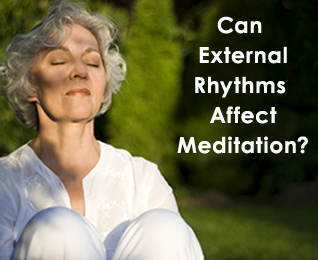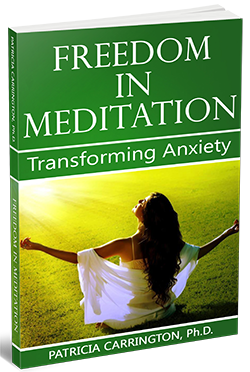 Influences of External Rhythms on Meditation
Influences of External Rhythms on Meditation
Do changes in the earth’s atmosphere or in the cosmos perhaps make certain times of a day more appropriate for meditating than others? How might other external fields of energy affect meditation?
There is obvious value in making meditation as much of a set routine as is genuinely comfortable. Linking times for meditation with some already established habit, such as getting out of bed in the morning or traveling to or from work on a bus or subway, or connecting it with any other regular event in our lives, can be a help in doing so, since this increases the regularity of our meditation in an easy, natural manner.
Despite the desirability of routine, evidence points to the fact that such strategies are useful in the long run, only if the regular time of day selected genuinely feels comfortable. It is logical that meditation, which leads us back to ourselves, be conducted in harmony with the ebb and flow of our energy and moods. This way it can remain a gentle process, an interlude during which we are truly kind to ourselves.
Research shows that our inner production schedule is closely coordinated with the wider rhythms of nature that determine sleep and activity each day. The light/darkness cycle, the lunar cycle, changes in electromagnetic fields (EMFs), and other geophysical events – all of these continually interact with our own in-built rhythms, forming part of a coordinated, oscillating system.
Solar Rhythms
As we increasingly recognize man’s interrelationship with his environment, it is clear that the human being is intricately coordinated with the rhythms of the universe. Sunlight, for instance, a fundamental influence in our lives, appears to synchronize us with the rhythms of our planet.
The influence of the moon is also important but it seems to have a greater daily influence on nocturnal animals than it does on humans, who are diurnal (that is, active during daylight hours).
As Michael Gauquelin pointed out, life on earth is particularly affected by the sun, because the earth resides in a very real sense within the ‘atmosphere’ of the sun. Not only can solar eruptions (‘sunspots’) interfere with electricity on earth, causing fade-outs in radio reception and accounting for intense geomagnetic storms that affect our weather conditions, living things, as widely different as fiddler crabs, chick embryos within eggs, and dry grain seeds have been shown to respond with incredible precision to the presence or absence of sunlight and to its varying intensities.
While the normal response of plants and animals to the daily arrival of the sun has been impressively documented, one need only sit quietly in a garden in the early morning hours to experience the transformation that accompanies the approach of the sun. The isolated chirpings and warbles of the early rising birds, the intermittent moaning of the mourning doves, the distant whirr of the grasshoppers, gradually swell in pre-dawn to an oratorio as the sun approaches the horizon – and when it finally swings into sight, sweeping the land with its rays, the bird sounds triumph, enveloping us. Daytime has brought new birth.
The Sun’s Influence on the Body

It is interesting that biometeorology, a branch of science which seeks to explore the influence of cosmic forces upon human and animal life, has documented, among other things, some of the unusual responses of organisms to the daily arrival of the sun. Particularly important from the point of view of considering best hours for meditation may be certain preliminary experiments performed in 1938 by a Japanese physician, Maki Takata, which suggest a little-known relationship between human blood serum and the sun.
Takata, who is renowned for developing a test for the flocculation of the blood (this is the blood’s propensity to curdle into small fluffy lumps when a chemical reagent is added to it in a test tube) found by chance that the ‘blood flocculation indexes’ of large numbers of Japanese people rose at times when sunspots were directing a concentrated beam of waves and particles toward the earth. The meaning of these changes in the blood serum with exposure to sunlight could not be determined, but Takata later demonstrated that this flocculation index regularly reaches an extreme low point in the early pre-waking hours of the morning. It then shows a sudden dramatic rise beginning about twenty minutes before sunrise, which continues at a somewhat reduced pace for about a half-hour following sunrise.
Going a step further, Takata then took subjects up in a plane to an extremely high altitude, where the ‘atmosphere shield’ against solar radiation is much thinner. As he had expected, he found that these subjects’ blood flocculation indexes rose sharply as the plane rose into the less shielded atmosphere. With greater exposure to solar radiation, the blood showed more marked changes, supporting the idea that the sun was involved in these changes in a very direct fashion.
Takata’s findings underline the importance of the great solar synchronizer in our lives. It is perhaps not surprising, therefore, that through the ages human beings have considered the moments of sunrise and sunset as having powerful, even mysterious properties, and that they have often linked religious practices and meditation with these times of day.
Primitive peoples, naturally rising before dawn, have often greeted the newborn morning sun with special ceremonies and worship. Until very recently, in fact, sunrise and sunset controlled most of humanity’s waking life.
Even today, Hindus still awaken in the very early hours of the morning and perform prescribed purifications, which include meditation and worship. Failure to meditate in the early morning hours is actually listed as one of the ‘fourteen failings’, and Sanskrit scriptures refer to pre-dawn as Brahma Mahoorta (time of pure consciousness) or Amrit Bela (time of the nectar of life).
In similar fashion, Moslems chant morning prayers at day’s commencement and pious Jews, rising to pray in a meditation-like state, are instructed to wait until there is ‘sunlight in the sky’ to begin actual prayer. Sunrise prayer and meditations are also used as special spiritual exercises in Christian, Buddhist and other monasteries.
Down through history the meditative mood, manifested in rituals, prayers or forms of meditation, has been prescribed to coincide with the rising and the setting sun. Countless observers in diverse areas of the world have found sunrise a time when they are moved to a sense of profound wonder and meaning. To a lesser degree, sunset has been considered an hour for contemplation, meditation, prayer or solemn ritual. The rise and decline of the sun, it seems, deeply affects our life and our moods.
Does this mean that meditation is most beneficial if it is coordinated with the natural cycles of light and darkness?
The belief that it should be probably cannot be separated from the total view of life subscribed to by people who consider all activities in relation to the natural cycles of earth, sun, moon, and universe. This point of view is particularly true of Yogic philosophy, where man, who is seen as part of the cosmos, is said to reflect the whole of which he is a part, and thus to contain within himself the pulsations and rhythms of the entire universe.
If a person were to meditate while on the outward swing of that person’s ultradian cycle (moving into a period of activity) what would happen? Would this make that person more resistant to meditation? Would it reduce the effectiveness of the meditation? Could such mistaken timing make a meditation entirely ineffective in certain instances, or perhaps even cause it to be an unpleasant experience?
In the other direction, we might wonder whether coordinating the timing of a meditation session with maximum inward swing of the ninety-minute cycle – those times when we naturally become ruminative, imaginative and physically quieter – might help us to realize the deepest possibilities of meditation.
While only careful research can answer these questions, in the meantime, observation of large numbers of meditators suggests that perhaps we intuitively observe our ultradian rhythms through our spontaneous choice of times to meditate, without realizing we are doing so.
Many of us naturally vary our meditation time on any particular day. We may have been thinking of meditating for a half-hour or so, but it is only at some particular moment that we find ourselves actually making an active effort to do so.
Are we perhaps instinctively timing our meditations to coincide with the inward swings of our own ultradian rhythms?
Until experimental answers to these questions are forthcoming, each of us has to discover, by trial and error, our own best hours for meditating each day.
Electromagnetic Fields (EMFs)
Editors. Note: Certainly, unnatural external influences can be considered when determining a time of day to meditate. While this article has primarily focused on natural environmental influences on meditation unnatural external energies, such as the increasing array of electromagnetic fields should also be considered.
A 2021 study, Specified Electromagnetic Radiation in the Wireless Signal Range Increases Wakefulness in Mice, identifies sleep alteration as a potential consequence of excessive exposure to electromagnetic radiation. Given that attaining a sense of calm through meditation, it might be beneficial to omit/distance yourself from the electromagnetic fields of cell phones, Wi-Fi, prior to meditating.
(I delve a bit deeper into some other “Intriguing Rhythms” that may affect meditation times in my classic book, Freedom in Meditation and my Learn to Meditate Course)
Related Product
 Learn to Meditate Course
Learn to Meditate Course
Recipient of the National Health Association Award for the Best Corporate Stress Management Program of the Year, the Learn to Meditate Course represents the simplest, safest, and most authoritative, affordable form of in-home- meditation instruction presently available for the general public.






